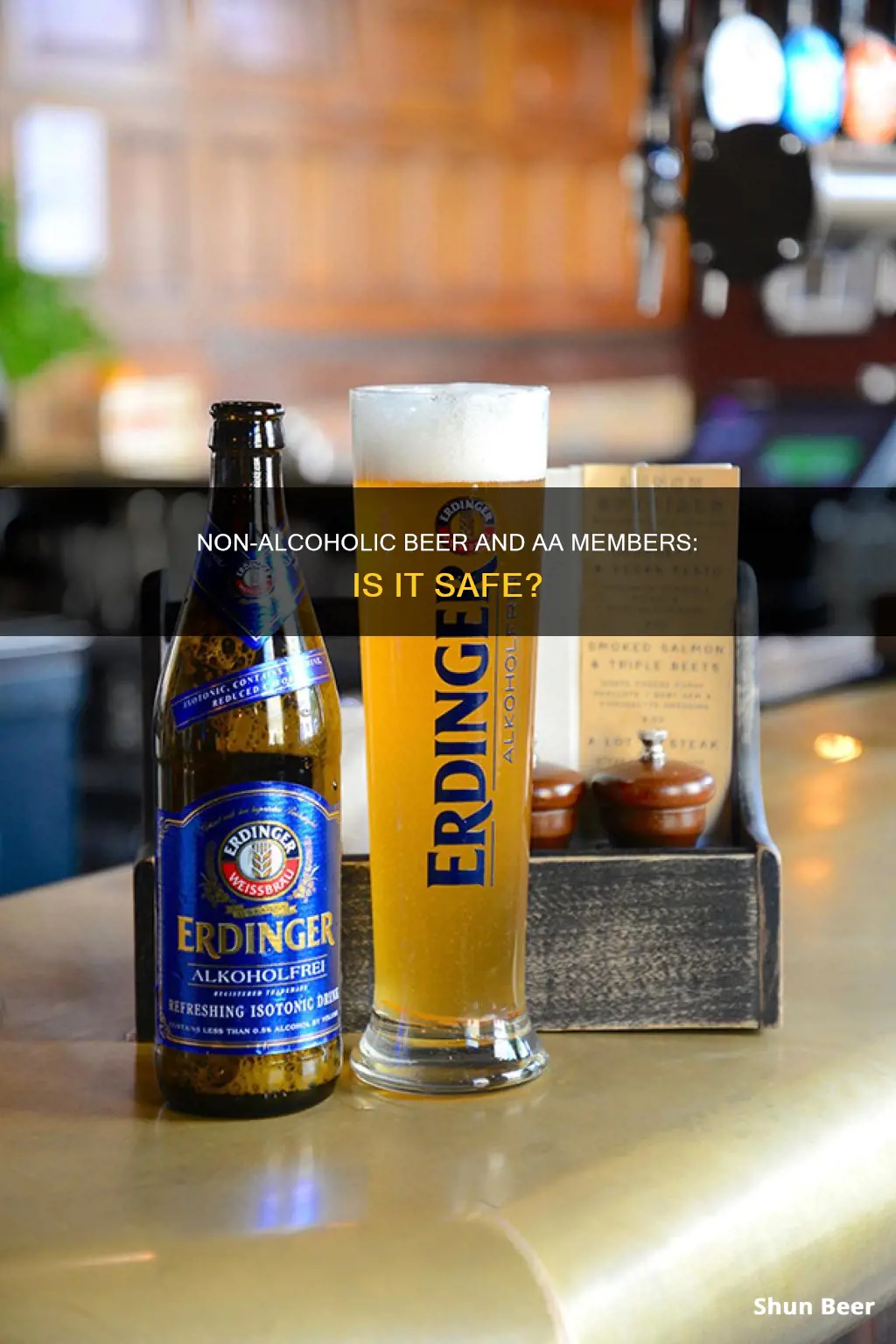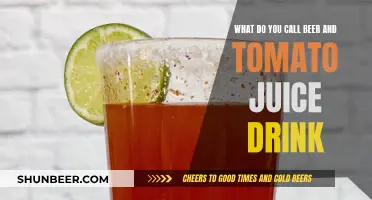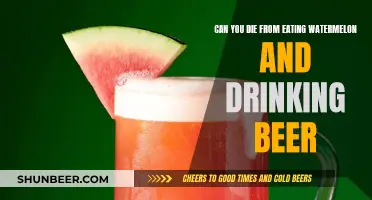
Non-alcoholic beer has become an increasingly popular alternative for those recovering from alcohol addiction. However, the question of whether consuming non-alcoholic beer breaks sobriety remains a highly debated topic within the recovery community. While some view it as a valuable tool to navigate social situations and avoid feelings of isolation, others consider it a potential trigger that could lead to a devastating relapse. So, can members of Alcoholics Anonymous (AA) drink non-alcoholic beer without compromising their sobriety? The answer may vary depending on the individual's unique circumstances, triggers, and recovery journey.
| Characteristics | Values |
|---|---|
| Alcohol content | Non-alcoholic beer typically contains 0.5% or less alcohol by volume (ABV). However, some non-alcoholic beers are completely alcohol-free, often labelled as 0.0% ABV. |
| Taste and appearance | Non-alcoholic beer is designed to taste, smell, and look like traditional beer. |
| Target audience | Non-alcoholic beer is marketed to individuals who want to enjoy the taste and social experience of drinking beer without the intoxicating effects of alcohol, including those in recovery from alcohol addiction. |
| Benefits | Non-alcoholic beer provides an option for those who want to avoid the negative consequences of alcohol abuse while still being able to participate in social situations where alcohol is present. It can help individuals feel included and reduce the pressure to consume alcoholic beverages. |
| Risks | For individuals with a history of alcohol addiction, non-alcoholic beer may trigger cravings and emotional associations with past drinking experiences, potentially leading to a relapse. The act of consuming a beer-like beverage can also trigger a placebo response, evoking sensations and emotions associated with alcohol consumption. |
| Opinions | There are differing opinions within the recovery community. Some view non-alcoholic beer as a relapse, while others see it as a way to re-engage in social situations and feel included. Sobriety coaches and recovering alcoholics also hold diverse viewpoints, with some advocating for complete abstinence and others finding non-alcoholic beer helpful in their recovery journey. |
What You'll Learn

Pros of non-alcoholic beer for alcoholics
Social Situations
For many recovering alcoholics, the most challenging part of recovery is the feeling of isolation it brings in social situations. Not being able to have a drink with dinner or at a ballgame can make them feel awkward, excluded, and different from their peers. Non-alcoholic drinks allow recovering alcoholics to blend in and feel included without compromising their sobriety.
A Path to Sobriety
For some contemplating sobriety, the idea of never drinking alcohol again can be so discouraging that they give up before they start. Non-alcoholic drinks create a space for people to begin restricting their drinking and addressing their addiction. Some people find this approach attainable and rewarding, and it can ultimately lead to total abstinence.
Health and Relaxation Benefits
Non-alcoholic beers are typically made from only four natural ingredients – water, yeast, malt, and hops – with barely any preservatives or added sugars. They can help people relax and unwind in stressful situations and aid insomnia, without compromising their recovery.
Low Alcohol Content
Non-alcoholic beer has a very low alcohol concentration – around 1/10th that of regular beer – so it is almost impossible to get drunk on it. This means that, unlike regular beer, non-alcoholic beer does not impair judgement or motor skills.
Jaundice Recovery: Is Beer a Friend or Foe?
You may want to see also

Cons of non-alcoholic beer for alcoholics
Risk of Relapse
Even non-alcoholic beer contains a small amount of alcohol (up to 0.5% ABV), which could cause a recovering alcoholic to relapse. In addition, the smell and taste of non-alcoholic beer may be enough to trigger cravings and cause a relapse. The sound of cracking open a can or the feel of a cold glass in one's hand can stimulate the release of dopamine in the brain, leading to a craving for alcohol.
Misleading Labeling
A study found that 30% of non-alcoholic beverages had ethanol levels higher than declared on the label, with some containing more than 1% ethanol. This means that individuals in recovery from alcoholism may unknowingly consume alcohol, which could lead to a relapse.
Triggers Euphoric Recall
Indulging in non-alcoholic beer can trigger "euphoric recall", where individuals selectively remember the good times of drinking and romanticize their previous drinking habits. This can weaken their commitment to sobriety and lead them to believe that they can manage to drink in moderation.
Not a True Substitute
Non-alcoholic beer does not have the same rich flavor as regular beer and may not provide the same satisfaction for those who enjoyed the taste of beer before developing a drinking problem.
High Cost
Non-alcoholic beer can be expensive, and it may not be a cost-effective option for those in recovery from alcoholism.
Vegan Beer: What's in Your Pint Glass?
You may want to see also

The placebo effect and sobriety
The placebo effect is a powerful phenomenon where the brain convinces the body that a fake treatment is real, stimulating healing. While the placebo effect was once considered a sign of failure in clinical trials, it is now understood as evidence of the presence of another, non-pharmacological mechanism at play.
The placebo effect is more than just positive thinking; it involves creating a stronger connection between the brain and body and how they work together. Placebos can be just as effective as traditional treatments for certain conditions, such as pain management, stress-related insomnia, and cancer treatment side effects. They work on symptoms modulated by the brain, like the perception of pain, and can make people feel better, but they will not cure the underlying condition.
Research has shown that individuals who are given a placebo drink and told that it contains alcohol will often experience mild intoxication, with increased activity in the reward network of the brain. Their behavior may also change, mirroring their past experiences with alcohol. This can include reduced anxiety, increased talkativeness, or a more positive mood. However, it is important to note that placebo drinkers are not actually getting drunk, and there are limits to the effects.
The placebo effect in sobriety can have both positive and negative implications. On the one hand, non-alcoholic beer can help individuals in recovery feel included during social occasions without putting their sobriety at risk. It provides a sense of normalcy and inclusivity, enabling them to enjoy the taste and experience of beer while maintaining their commitment to sobriety. On the other hand, consuming non-alcoholic beer may also trigger cravings and remind individuals of past drinking experiences, potentially placing their sobriety at risk.
The impact of NA drinks on alcohol cravings is an area that requires further study, especially for those with a tendency toward addiction. While non-alcoholic beverages can be a valuable tool for some in recovery, it is crucial for individuals to assess their own triggers and intentions and make an informed decision about whether these drinks are suitable for their unique journey to sobriety.
Cialis and Beer: Safe Mix or Health Risk?
You may want to see also

Triggers and cravings in sobriety
Triggers and cravings are a normal part of the addiction recovery process. They are associated with one another because they are usually experienced together. A trigger is a cue or reminder that puts mental or emotional strain on a person, and cravings are the strong feelings of desire for something that follow. In recovery, cravings are a strong desire to use substances or get high.
How to identify triggers
To identify your triggers, consider the people, places, and situations that make you feel an urge to use. It is important to note that triggers are not always associated directly with drugs or alcohol. General feelings of stress, anxiety, or mental distress can also be triggers, especially if substances were used to self-medicate.
How to identify cravings
Cravings can manifest as a physical response in your body, such as your stomach turning, your chest tightening, and your muscles aching. They can also be mental, showing up in your thoughts and emotions, for example, "I need it now" or "I can't stop thinking about it".
How to manage triggers and cravings
To manage triggers, you can keep a journal, challenge intrusive thoughts, seek advice, and recognize that these triggers and cravings are temporary. To work through cravings, focus on managing your triggers and utilize mindfulness techniques or self-care to remind yourself of your long-term recovery goals.
Strategies to prevent relapse
- Avoid high-risk situations by keeping little to no alcohol at home and socially avoiding activities involving drinking.
- Cope with triggers by reminding yourself why you are sober, talking through the craving with a sponsor, distracting yourself with another activity, or leaving high-risk situations.
- Mutual support groups such as Alcoholics Anonymous or Narcotics Anonymous can help you maintain your resolve to avoid substances and overcome cravings.
- Mindfulness-based relapse prevention (MBRP) can help you maintain a non-judgmental, accepting attitude throughout your recovery journey.
- Distraction strategies such as music therapy or art therapy can serve as a helpful way to temporarily relieve cravings.
- Stress management techniques like yoga can be beneficial, as stress can play a role in cravings and relapse.
The risks of non-alcoholic beer for people in recovery
The question of whether non-alcoholic beer can be consumed by people in recovery is a complex one. While some people feel that it provides a valuable alternative to total abstinence, others argue that it poses a significant risk of triggering a relapse. The sound of opening a can, the smell, or the sensation of drinking a beer can stimulate the reward centers of the brain to release dopamine, causing a craving for the real thing.
In conclusion, triggers and cravings are a common and challenging aspect of sobriety. While they can be difficult to manage, there are a variety of strategies that can help individuals in recovery identify and cope with them effectively. It is important to remember that recovery is an ongoing process, and maintaining sobriety requires continuous work and commitment.
Asking for Beer Outside Gas Stations: Does It Work?
You may want to see also

Opinions from sobriety coaches
Sobriety coaches are divided when it comes to non-alcoholic beer. Some coaches believe that individuals in recovery from alcohol addiction should abstain completely from any beverage that resembles alcohol, as it may increase the risk of relapse. This view holds that the taste, smell, and ritual of drinking beer are too closely associated with the physical and mental changes that alcohol brings, and could be traumatic or triggering for those in recovery. Additionally, the very idea of consuming alcohol, even in trace amounts, can be disturbing and have a tumultuous impact on an individual's recovery journey.
On the other hand, some sobriety coaches take a more moderate stance, recognising non-alcoholic beer as a potential harm-reduction tool when consumed responsibly. They argue that non-alcoholic beer can help individuals in recovery feel included in social situations, enabling them to participate in gatherings without feeling left out or pressured to consume alcoholic drinks. It provides a sense of normalcy and allows them to enjoy the taste and experience of beer while maintaining their commitment to sobriety.
The decision to consume non-alcoholic beer during recovery is a highly individualised one. It depends on a person's unique circumstances, triggers, and their ability to recognise and deal with those triggers. For some, non-alcoholic beer may be a valuable tool to navigate social situations, while for others, it may pose too great a risk. Ultimately, the decision lies with each person based on their understanding of their recovery journey and personal preferences.
Appendix Surgery: Beer Drinking Timeline and Safety
You may want to see also
Frequently asked questions
There is no clear consensus on whether AA members can or cannot drink non-alcoholic beer. Some people believe that it is acceptable as long as the drink contains absolutely no alcohol, while others argue that even the slightest amount of alcohol, typically up to 0.5% alcohol by volume (ABV), can be dangerous for someone in recovery. Ultimately, it is a personal decision that each individual has to make for themselves, weighing the risks and benefits.
The main risk is that it could trigger a relapse. Even a small amount of alcohol can be dangerous for someone with an addiction, and the taste, smell, or ritual of drinking beer may be enough to set off a cascade of negative consequences. Additionally, the very idea of consuming alcohol, even in trace amounts, can be disturbing for someone in recovery.
Non-alcoholic beer can help individuals in recovery feel included in social situations where alcohol is present. It can provide a sense of normalcy and reduce the pressure to drink, especially in networking events or social gatherings. It can also be a way to enjoy the taste of beer without the intoxicating effects of alcohol.
Alternatives include alcohol-free options that do not smell or taste like the subject of the individual's addiction, such as a virgin piña colada or a soda. However, it is important to avoid choices that are too similar to the beverages favoured during drinking days.
Non-alcoholic beers date back to the Prohibition era in the United States, when the Volstead Act made any beverage with over 0.5% ABV illegal. This led to the creation of "near beer," which had a very pale colour, not much flavour, and fell right at the 0.5% ABV limit. After Prohibition ended in 1933, non-alcoholic beer persisted because consumers had developed a taste for it, and some American brands created bland, light beers to cater to this demand.







